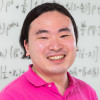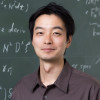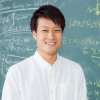Seminar
757 events
-
Seminar
Introduction to the replica method
June 23 (Wed) at 13:30 - 15:40, 2021
Yoshiyuki Kabashima (Professor, Graduate School of Science, The University of Tokyo)
The replica method is a mathematical technique for evaluating the "quenched" average of logarithm (or a real number power) of the partition function with respect to predetermined random variables that condition the objective system. The technique has a long history, dating back at least to a book by Hardy et al in 1930s, but has become well known only since its application to the physics of spin glasses in 1970s. More recently, its application range is spreading rapidly to various fields in information science, including information theory, communication theory, signal processing, computational complexity theory, machine learning, etc. In this talk, we introduce the basic idea of the replica method and its mathematical fault illustrating a few examples. *Detailed information about the seminar refer to the email.
Venue: via Zoom
Event Official Language: English
-
Seminar

Black Hole Information Paradox and Wormholes
June 21 (Mon) at 13:00 - 14:30, 2021
Kanato Goto (Special Postdoctoral Researcher, RIKEN Interdisciplinary Theoretical and Mathematical Sciences Program (iTHEMS))
In this talk, I will explain about the recent progress in the black hole information paradox that I am involved with. The information paradox arises when a black hole evaporates by emitting Hawking radiation due to the quantum effects. Time dependence of the entropy of Hawking radiation is diagnosis of information loss caused by the black hole evaporation. If information is not lost, the entropy of Hawking radiation should obey the so-called Page curve. In recent research developments, it was found that “the quantum extremal islands” reproduce the unitary Page curve in an evaporating black hole. I will argue about how the quantum extremal islands are derived from the computation of the entropy of Hawking radiation using the gravitational path-integral.
Venue: via Zoom
Event Official Language: English
-
Seminar

Stable eigenvalues of compact anti-de Sitter 3-manifolds
June 18 (Fri) at 16:00 - 18:10, 2021
Kazuki Kannaka (Special Postdoctoral Researcher, RIKEN Interdisciplinary Theoretical and Mathematical Sciences Program (iTHEMS))
Geometric objects that have been investigated in detail so far, such as closed Riemann surfaces, are sometimes locally homogeneous. Loosely speaking, their infinitesimal behavior is the same at each point. In this talk, I would like to explain the idea of investigating such objects using the Lie group theory.In the first part of the talk, I will recall the notions of Lie group actions and their quotient spaces with examples, and then explain the definitions of locally homogeneous spaces and their deformations (Teichmüller spaces). In the second part of the talk, I will consider anti-de Sitter manifolds as a special case, i.e., Lorentzian manifolds of negative constant curvature. As in the Riemannian case, a differential operator called the Laplacian (or the Klein-Gordon operator) is defined on Lorentzian manifolds. Unlike the Riemannian case, it is no longer an elliptic differential operator but a hyperbolic differential operator. In its spectral analysis, new phenomena different from those in the Riemannian case have been discovered in recent years, following pioneering works by Toshiyuki Kobayashi and Fanny Kassel. I would like to explain stable eigenvalues of the hyperbolic Laplacian of anti-de Sitter 3-manifolds with recent progress.
Venue: via Zoom
Event Official Language: English
-
Seminar

The origin and dispersal of buckwheat
June 10 (Thu) at 10:00 - 11:00, 2021
Jeffrey Fawcett (Senior Research Scientist, RIKEN Interdisciplinary Theoretical and Mathematical Sciences Program (iTHEMS))
Buckwheat, which soba noodles is made from, originated from a wild species that is distributed in southwest China, around Yunnan, Sichuan, and Tibet. We are trying to understand when, where, and how it originated and then spread across the world and came to Japan. To do so, we are using genomic data of wild samples from China and cultivated samples from various parts of the world. I will give a brief introduction about buckwheat, explain what we already know about its origin and dispersal, and show a bit of our results. I will also explain the significance of studying "domestication", that is, the process that plants/animals that humans currently use originated from their ancestral wild species. *Please refer to the email to get access to the Zoom meeting room.
Venue: via Zoom
Event Official Language: English
-
Seminar

iTHEMS-phys Intro Meeting on June 7, 2021
June 7 (Mon) at 13:00 - 14:30, 2021
Tomoya Naito (Ph.D. Student, Department of Physics, Graduate School of Science, The University of Tokyo)
Takeru Yokota (Postdoctoral Researcher, The Institute for Solid State Physics (ISSP), The University of Tokyo)
Naomi Tsuji (Postdoctoral Researcher, RIKEN Interdisciplinary Theoretical and Mathematical Sciences Program (iTHEMS))13:00-13:20 [JST] Tomoya Naito 13:20-13:40 [JST] Takeru Yokota 13:40-14:00 [JST] Naomi Tsuji 14:00- Free discussion
Venue: via Zoom
Event Official Language: English
-
Seminar

An overview of genome-wide epistasis and co-selection analysis
June 3 (Thu) at 10:00 - 11:00, 2021
Yingying Xu (Special Postdoctoral Researcher, RIKEN Interdisciplinary Theoretical and Mathematical Sciences Program (iTHEMS))
This talk is a summary of research that have done by me and my team during 2016~2019. I was a postdoc researcher in Aalto university/Helsinki university in Finland. In the team, a worldwide active collaboration has happened between many fields including statistical physics, biology, computer science and statistics. The target is to analyze ultra-high dimensional large population genomic datasets of two major human pathogens, Streptococcus pneumoniae and Neisseria meningitidis, without phenotypic data. Interacting networks of resistance, virulence and core machinery genes are identified. Many different approaches have been invented and they can be generally applied to other datasets with similar mathematical setting. I will explain methods based on statistical model [1,2], mutual information [3], and theoretical performance analysis for statistical model [4]. In the end, I will briefly introduce a new phenomenon of random matrix which is discovered during the research process for statistical significance filtering [5]. *Please refer to the email to get access to the Zoom meeting room.
Venue: via Zoom
Event Official Language: English
-
Seminar

iTHEMS-phys Intro Meeting on June 1, 2021
June 1 (Tue) at 13:00 - 15:00, 2021
Kengo Kikuchi (Special Postdoctoral Researcher, RIKEN Interdisciplinary Theoretical and Mathematical Sciences Program (iTHEMS))
Enrico Rinaldi (Research Fellow, Physics Department, University of Michigan, USA)
Hiroshi Yokota (Postdoctoral Researcher, RIKEN Interdisciplinary Theoretical and Mathematical Sciences Program (iTHEMS))13:00-13:20 [JST] Kengo Kikuchi 13:20-13:40 [JST] Enrico Rinaldi 13:40-14:00 [JST] Hiroshi Yokota 14:00- Free discussion
Venue: via Zoom
Event Official Language: English
-
Seminar

iTHEMS-phys Intro Meeting on May 31, 2021
May 31 (Mon) at 13:00 - 15:00, 2021
Ryo Namba (Senior Research Scientist, RIKEN Interdisciplinary Theoretical and Mathematical Sciences Program (iTHEMS))
Naritaka Oshita (Special Postdoctoral Researcher, RIKEN Interdisciplinary Theoretical and Mathematical Sciences Program (iTHEMS))
Yuki Yokokura (Senior Research Scientist, RIKEN Interdisciplinary Theoretical and Mathematical Sciences Program (iTHEMS))
Shigehiro Nagataki (Chief Scientist, Astrophysical Big Bang Laboratory, RIKEN Cluster for Pioneering Research (CPR))13:00-13:20 [JST] Ryo Namba 13:20-13:40 [JST] Naritaka Oshita (10 mins break) 13:50-14:10 [JST] Yuki Yokokura 14:10-14:30 [JST] Shigehiro Nagataki 14:30- Free discussion
Venue: via Zoom
Event Official Language: English
-
Seminar
Magnetorotational Instability: Current Understanding and Perspective
May 28 (Fri) at 16:00 - 17:00, 2021
Takashi Minoshima (Researcher, Japan Agency for Marine-Earth Science and Technology (JAMSTEC))
The differentially rotating flow can be destabilized in the presence of a weak magnetic field through the magnetorotational instability (MRI). The MRI is considered as a possible mechanism for outward angular momentum transport and subsequent mass accretion in accretion disks. Numerous studies have been devoted to understand its nature and judge whether it can supply the power sufficient for observed transport efficiency. For example, the MHD simulation studies have attempted to reveal the scaling of the MRI on numerical (e.g., resolution and domain size) as well as physical parameters (e.g., magnetic field intensity and configuration). In this talk, I would like to discuss current understanding and perspective of the MRI through theoretical and numerical studies. I will especially focus on the impact of transport coefficients (viscosity, resistivity, and their ratio) on the evolution of the MRI and disk.
Venue: via Zoom
Event Official Language: English
-
Seminar
A Mathematical Model for Stem Cell Competition to Maintain a Cell Pool Injured by Radiation Exposure
May 27 (Thu) at 10:00 - 11:00, 2021
Kouki Uchinomiya (Central Research Institute of Electric Power Industry)
Cancer risk of low-dose-rate ionizing radiation exposure is one of the most important issues in radiation protection. Tissue stem cells have been considered one of the targets of radiation-induced carcinogenesis. There has been a hypothesis that the carcinogenic effects of radiation can be reduced if damaged stem cells are eliminated via stem cell competition between damaged and intact stem cells. This would be particularly effective under very low-dose-rate conditions, where only a few stem cells in a stem cell pool are affected by radiation. In this presentation, I will introduce a simple mathematical model to discuss the influence of stem cell competition on the accumulation of radiation damage and show that the character of damaged cells and the size of the stem cell pool may affect the accumulation of radiation damage. *Please refer to the email to get access to the Zoom meeting room.
Venue: via Zoom
Event Official Language: English
-
Seminar
Theory of Anomalous Floquet Higher-Order Topology
May 26 (Wed) at 22:00 - 23:15, 2021
Rui-Xing Zhang (University of Maryland, College Park, USA)
Periodically-driven or Floquet systems can realize anomalous topological phenomena that do not exist in any equilibrium states of matter, whose classification and characterization require new theoretical ideas that are beyond the well-established paradigm of static topological phases. In this work, we provide a general framework to understand anomalous Floquet higher-order topological insulators (AFHOTIs), the classification of which has remained a challenging open question. In two dimensions (2D), such AFHOTIs are defined by their robust, symmetry-protected corner modes pinned at special quasienergies, even though all their Floquet bands feature trivial band topology. The corner-mode physics of an AFHOTI is found to be generically indicated by 3D Dirac/Weyl-like topological singularities living in the phase spectrum of the bulk time-evolution operator. Physically, such a phase-band singularity is essentially a "footprint" of the topological quantum criticality, which separates an AFHOTI from a trivial phase adiabatically connected to a static limit. Strikingly, these singularities feature unconventional dispersion relations that cannot be achieved on any static lattice in 3D, which, nevertheless, resemble the surface physics of 4D topological crystalline insulators. We establish the above higher-order bulk-boundary correspondence through a dimensional reduction technique, which also allows for a systematic classification of 2D AFHOTIs protected by point group symmetries. We demonstrate applications of our theory to two concrete, experimentally feasible models of AFHOTIs protected by C2 and D4 symmetries, respectively. Our work paves the way for a unified theory for classifying and characterizing Floquet topological matters. *Detailed information about the seminar refer to the email.
Venue: via Zoom
Event Official Language: English
-
Seminar

iTHEMS-phys Intro Meeting on May 25, 2021
May 25 (Tue) at 13:00 - 15:00, 2021
Takuya Sugiura (Postdoctoral Researcher, RIKEN Interdisciplinary Theoretical and Mathematical Sciences Program (iTHEMS))
Takumi Doi (Senior Research Scientist, Quantum Hadron Physics Laboratory, RIKEN Nishina Center for Accelerator-Based Science (RNC))
Shoichiro Tsutsui (Special Postdoctoral Researcher, Quantum Hadron Physics Laboratory, RIKEN Nishina Center for Accelerator-Based Science (RNC))
Kanato Goto (Special Postdoctoral Researcher, RIKEN Interdisciplinary Theoretical and Mathematical Sciences Program (iTHEMS))13:00-13:20 [JST] Takuya Sugiura 13:20-13:40 [JST] Takumi Doi (10 mins break) 13:50-14:10 [JST] Schoichiro Tsutsui 14:10-14:30 [JST] Kanato Goto 14:30- Free discussion
Venue: via Zoom
Event Official Language: English
-
Seminar

Loewner's theorem for maps on operator domains / The structure of maps on the space of all quantum pure states that preserve a fixed quantum angle
May 24 (Mon) at 16:00 - 18:10, 2021
Michiya Mori (Special Postdoctoral Researcher, RIKEN Interdisciplinary Theoretical and Mathematical Sciences Program (iTHEMS))
This talk is divided into two independent topics. In the first part of my talk we consider the order structure of hermitian matrices. Given two matrix domains (open connected sets of n-by-n hermitian matrices), what is the general form of order isomorphisms between them? I will explain that there is a complete correspondence between the class of order isomorphisms and that of biholomorphic mappings. In the second part we consider the metric structure of the space P(H) of all quantum pure states (= the projective space of a complex Hilbert space H). Wigner's theorem asserts that every surjective isometry of P(H) onto itself is implemented by a unitary or an antiunitary operator. Uhlhorn generalized Wigner's theorem by showing that every bijective transformation of P(H) that preserves orthogonality is implemented by a unitary or an antiunitary operator. We consider some variants of Uhlhorn's result. The first part is joint work with P. Semrl (Univ. of Ljubljana), and the second part with G.P. Geher (Univ. of Reading). Only basic linear algebra is assumed in both parts.
Venue: via Zoom
Event Official Language: English
-
Seminar

iTHEMS-phys Intro Meeting on May 24, 2021
May 24 (Mon) at 13:00 - 14:30, 2021
Hidetoshi Taya (Special Postdoctoral Researcher, RIKEN Interdisciplinary Theoretical and Mathematical Sciences Program (iTHEMS))
Yuta Sekino (Visiting Researcher, RIKEN Interdisciplinary Theoretical and Mathematical Sciences Program (iTHEMS))
Ching-Kai Chiu (Senior Research Scientist, RIKEN Interdisciplinary Theoretical and Mathematical Sciences Program (iTHEMS))13:00-13:20 [JST] Hidetoshi Taya 13:20-13:40 [JST] Yuta Sekino 13:40-14:00 [JST] Ching-Kai Chiu 14:00- Free discussion
Venue: via Zoom
Event Official Language: English
-
Seminar
Organ-to-organ two-way coupling contributes to the stabilization of circadian clock in Arabidopsis.
May 20 (Thu) at 10:00 - 11:00, 2021
Kyohei Uemoto (Kyoto University / NARA Institute of Science and Technology)
Circadian clocks increase plant fitness by anticipating periodic environmental changes using unstable temporal information perceived in each tissue/organ. However, little is known about how such local and noisy temporal information regulates global and coordinated plant growth. Here, we show that nutrient-mediated two-way communication between shoots and roots stabilizes circadian rhythms and aids plant growth. The photosynthetic product, sucrose, is transported from the shoot to the root, where it regulates the expression of a clock gene and nutrients uptake rhythms. A lack of nutrient rhythms destabilizes the shoot circadian rhythms and reduces the growth rate. Our mathematical model supports that two-way communication between organs reduces the heterogeneity of the circadian rhythm, thereby maintaining the robustness of the circadian clock in a noisy environment. As with feedback loops in other hierarchies, nutrient-mediated shoot-root interorgan communication of the circadian clock is advantageous for proper growth under fluctuating environmental conditions. *Please refer to the email to get access to the Zoom meeting room.
Venue: via Zoom
Event Official Language: English
-
Seminar

Journal Club: Intrinsically Disordered Region (IDR)
May 19 (Wed) at 13:00 - 14:00, 2021
Kyosuke Adachi (Special Postdoctoral Researcher, RIKEN Interdisciplinary Theoretical and Mathematical Sciences Program (iTHEMS) / Special Postdoctoral Researcher, Nonequilibrium Physics of Living Matter RIKEN Hakubi Research Team, RIKEN Center for Biosystems Dynamics Research (BDR))
A class of protein domain, which is called intrinsically disordered region (IDR), is known to take no rigid three dimensional structure. Recent studies have shown that IDRs can show biological functions through phase separation, and it is important to clarify what kind of amino acid sequence of IDR leads to phase separation and what kind of mutation results in malfunction. In this journal club, I will discuss these topics by reviewing recent papers. *Detailed information about the seminar refer to the email.
Venue: via Zoom
Event Official Language: English
-
Seminar

iTHEMS-phys Intro Meeting on May 18, 2021
May 18 (Tue) at 13:00 - 14:30, 2021
Masaru Hongo (Postdoctoral Research Associate, Physics Department, The University of Illinois at Chicago (UIC), USA)
Etsuko Itou (Contract Researcher, Strangeness Nuclear Physics Laboratory, RIKEN Nishina Center for Accelerator-Based Science (RNC))
Nobuyuki Matsumoto (Special Postdoctoral Researcher, Computing Group, RIKEN BNL Research Center, RIKEN Nishina Center for Accelerator-Based Science (RNC))13:00-13:20 [JST] Masaru Hongo 13:20-13:40 [JST] Etsuko Itou 13:40-14:00 [JST] Nobuyuki Matsumoto 14:00- Free discussion
Venue: via Zoom
Event Official Language: English
-
Seminar

iTHEMS-phys Intro Meeting on May 17, 2021
May 17 (Mon) at 13:00 - 14:30, 2021
Tetsuo Hatsuda (Program Director, RIKEN Interdisciplinary Theoretical and Mathematical Sciences Program (iTHEMS))
Akira Harada (Special Postdoctoral Researcher, RIKEN Interdisciplinary Theoretical and Mathematical Sciences Program (iTHEMS))
Tsukasa Tada (Vice Chief Scientist, Quantum Hadron Physics Laboratory, RIKEN Nishina Center for Accelerator-Based Science (RNC))13:00-13:20 [JST] Tetsuo Hatsuda 13:20-13:40 [JST] Akira Harada 13:40-14:00 [JST] Tsukasa Tada 14:00- Free discussion
Venue: via Zoom
Event Official Language: English
-
Seminar

Geometry of canonical metrics on Kähler manifolds
May 14 (Fri) at 16:00 - 18:10, 2021
Eiji Inoue (Special Postdoctoral Researcher, RIKEN Interdisciplinary Theoretical and Mathematical Sciences Program (iTHEMS))
The aim of this talk is to report recent trends in Kähler geometry. Kähler geometry consists of two aspects: the one is algebraic geometry and the other is metric geometry.The first one hour is an introduction for non-mathematicians. I begin with a simple example of algebraic variety from ancient Greek, which I believe is the simplest example illustrating motivation for compact complex manifolds. On the other hand, I explain the first motivation for canonical metrics in Kähler geometry via Riemann’s uniformization theorem.The last one hour is an introduction to recent trends in Kähler geometry, especially Kähler-Einstein metrics. The existence of Kähler-Einstein metrics turns out to be related to geometry of degenerations of space, which is so called Yau-Tian-Donaldson conjecture. I explain various aspects of this topic. We encounter deep studies in metric geometry, birational geometry and non-archimedean geometry. I finally explain recent breakthrough on Kähler-Ricci flow.The goal of this talk is the starting point of my study. I briefly explain my study if time permits.
Venue: via Zoom
Event Official Language: English
-
Seminar

Modeling Membrane Morphological Change during Autophagosome Formation
May 14 (Fri) at 10:00 - 11:00, 2021
Yuji Sakai (Visiting Scientist, RIKEN Interdisciplinary Theoretical and Mathematical Sciences Program (iTHEMS) / Assistant Professor, Graduate School of Medicine and Faculty of Medicine, The University of Tokyo)
Membrane-bound organelles compartmentalize eukaryotic cells and adopt various characteristic shapes such as disk-shaped, tubules, spherical vesicles, and their intermediate structures. Organellar morphology is regulated by protein and lipid compositions. Because organellar shape directly relates to organellar function, it is important to understand the mechanisms regulating organelle morphology. In autophagy, the morphologies of the isolation membrane change from disk- to cup-shaped, closed spherical double-membrane structure. Eventually the membrane engulfs the cytoplasmic materials. In this study [1], we investigate the dynamics of the continuous membrane morphological transition in autophagy, which is governed by the spatiotemporal regulation of curvature generators. *Please refer to the email to get access to the Zoom meeting room.
Venue: via Zoom
Event Official Language: English
757 events
Events
Categories
series
- iTHEMS Colloquium
- MACS Colloquium
- iTHEMS Seminar
- iTHEMS Math Seminar
- DMWG Seminar
- iTHEMS Biology Seminar
- iTHEMS Theoretical Physics Seminar
- Information Theory SG Seminar
- Quantum Matter Seminar
- ABBL-iTHEMS Joint Astro Seminar
- Math-Phys Seminar
- Quantum Gravity Gatherings
- RIKEN Quantum Seminar
- Quantum Computation SG Seminar
- Asymptotics in Astrophysics SG Seminar
- GW-EOS WG Seminar
- DEEP-IN Seminar
- NEW WG Seminar
- Lab-Theory Standing Talks
- QFT-core Seminar
- STAMP Seminar
- QuCoIn Seminar
- Number Theory Seminar
- Academic-Industrial Innovation Lecture
- Berkeley-iTHEMS Seminar
- iTHEMS-RNC Meson Science Lab. Joint Seminar
- RIKEN Quantum Lecture
- Theory of Operator Algebras
- iTHEMS Intensive Course-Evolution of Cooperation
- Introduction to Public-Key Cryptography
- Knot Theory
- iTHES Theoretical Science Colloquium
- SUURI-COOL Seminar
- iTHES Seminar
